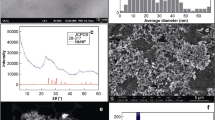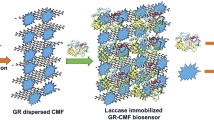Abstract
A novel electrochemical sensor for paraquat determination was facilely developed using nanocomposites of cellulose incorporated with manganese oxide (MnO2@cellulose) modified screen-printed carbon electrode (SPCE). In this study, SPCE was fabricated on a low-cost poster paper, and nanocellulose from sugarcane bagasse was employed to enhance the electrode’s surface area and improve the dispersion of MnO2. The MnO2@cellulose modified poster-SPCE exhibited a high electrochemical response toward paraquat. Various influencing factors, including differential pulse voltammetric parameters and accumulation time, were systematically explored. Under the optimal conditions, the cathodic peak current was linearly proportional to paraquat concentration in a range of 2 to 200 µM, featuring a low detection limit of 1 µM. The proposed sensor offers cost-effectiveness and can be readily prepared via a simple procedure. Moreover, this method exhibits excellent reproducibility, high selectivity, and a short analysis time. The portable electrochemical sensor was able to determine paraquat in water samples with acceptable recoveries from 95.45 to 109.20%, indicating that the sensor based on MnO2@cellulose/SPCE is reliable for paraquat quantification.
Graphical abstract








Similar content being viewed by others
References
Rajaram R, Neelakantan L (2023) Recent advances in estimation of paraquat using various analytical techniques: a review. Res Chem 5:100703
Laghrib F, Bakasse M, Lahrich S, El MA, Mhammedi (2020) Electrochemical sensors for improved detection of paraquat in food samples: a review. Mater Sci Eng C 107:110349
Siangproh W, Somboonsuk T, Chailapakul O, Songsrirote K (2017) Novel colorimetric assay for paraquat detection on-silica bead using negatively charged silver nanoparticles. Talanta 174:448–453
Cancino J, Soto K, Tapia J, Muñoz-Quezada MT, Lucero B, Contreras C, Moreno J (2023) Occupational exposure to pesticides and symptoms of depression in agricultural workers. A systematic review. Environ Res 231:116190
Guo H, Li L, Gao L (2023) Paraquat and Diquat: recent updates on their pretreatment and analysis methods since 2010 in biological samples. Molecules 28(2):684
Smith LL (1985) Paraquat toxicity. Phil Trans R Soc Lond B 311:647–657
Raghu K, Mahesh V, Sasidhar P, Reddy PR, Venkataramaniah V, Agrawal A (2013) Paraquat poisoning: a case report and review of literature. J Family Commun Med 20:198–200
Kim JW, Kim DS (2019) Paraquat: toxicology and impacts of its ban on human health and agriculture. Weed Sci 68:208–213
Chuntib P, Jakmunee J (2015) Simple flow injection colorimetric system for determination of paraquat in natural water. Talanta 144:432–438
YaÑez-SedeÑo P, Polo LM, Diez (1986) Spectrophotometric determination of paraquat with BiI – 4 in the presence of gum arabic. Talanta 33:745–747
Rai MK, Das JV, Gupta VK (1997) A sensitive determination of paraquat by spectrophotometry. Talanta 45:343–348
Sha O, Cui B, Chen X, Liu H, Yao J, Zhu Y (2020) Separation and determination of paraquat and diquat in human plasma and urine by magnetic dispersive solid phase extraction coupled with high-performance liquid chromatography. J Anal Methods Chem 2020:7359582
Hao C, Zhao X, Morse D, Yang P, Taguchi V (2013) Morra optimized liquid chromatography tandem mass spectrometry approach for the determination of diquat and paraquat herbicides. J Chromatogr A 1304:169–176
Gao L, Liu J, Wang C, Liu G, Niu X, Shu C, Zhu J (2014) Fast determination of paraquat in plasma and urine samples by solid-phase microextraction and gas chromatography–mass spectrometry. J Chromatogr B 944:136–140
Ghanbary E, Asiabani Z, Hosseini N, Kiaie SH, Kaki S, Ghasempour H, Babakhanian A (2020) The development of a new modified graphite pencil electrode for quantitative detection of gibberellic acid (GA3) herbal hormone. Microchem J 157:105005
Abolghasemi MM, Ghorbani-Cheghamarania A, Babakhanian A (2017) A novel electrochemical sensing platform based on Pt/PPy/Eosin-Y for the determination of cadmium. New J Chem 41:11335–11341
Traiwatcharanon P, Siriwatcharapiboon W, Jongprateep O, Wongchoosuk C (2022) Electrochemical paraquat sensor based on lead oxide nanoparticles. RSC Adv 12:16079–16092
Upan J, Lerdsri J, Soongsong J, Mool-Am-Kha P, Sridara T, Reanpang P, Jakmunee J (2022) A novel and portable electrochemical sensor for 5-hydroxymethylfurfural detection using silver microdendrite electrodeposited paper-based electrode. Analyst 147:2170–2179
Veeramani V, Dinesh B, Chen SM, Saraswathi R (2016) Electrochemical synthesis of Au–MnO2 on electrophoretically prepared graphene nanocomposite for high performance supercapacitor and biosensor applications. J Mater Chem A 4:3304–3315
Mahmoudian MR, Alias Y, Basirun WJ, Woi PM, Sookhakian M (2014) Facile preparation of MnO2 nanotubes/reduced graphene oxide nanocomposite for electrochemical sensing of hydrogen peroxide. Sens Actuators B 201:526–534
Wu ZL, Li CK, Yu JG, Chen XQ (2017) MnO2/reduced graphene oxide nanoribbons: facile hydrothermal preparation and their application in amperometric detection of hydrogen peroxide. Sens Actuators B 239:544–552
Ye Y, Sun X, Zhang Y, Han X, Sun X (2022) A novel cell-based electrochemical biosensor based on MnO2 catalysis for antioxidant activity evaluation of anthocyanins. Biosens Bioelectron 202:113990
Dontsova EA, Zeifman YS, Budashov IA, Eremenko AV, Kalnov SL, Kurochkin IN (2011) Screen-printed carbon electrode for choline based on MnO2 nanoparticles and choline oxidase/polyelectrolyte layers. Sens Actuators B 159:261–270
Thongsomboon W, Srihanam YBP, Srihanam P (2023) Valorization of cellulose-based materials from agricultural Waste: comparison between sugarcane bagasse and rice straw. Polymers 15:3190
Azmin SNHM, binti NA, Hayat M, Nor MSM (2020) Development and characterization of food packaging bioplastic film from cocoa pod husk cellulose incorporated with sugarcane bagasse fibre. J Bioresour Bioprod 5:248–255
Farooq A, Patoary MK, Zhang M, Mussana H, Li M, Naeem MA, Mushtaq M, Farooq A, Liu L (2020) Cellulose from sources to nanocellulose and an overview of synthesis and properties of nanocellulose/zinc oxide nanocomposite materials. Int J Biol Macromol 154:1050–1073
Fatema N, Ceballos RM, Fan C (2022) Modifications of cellulose-based biomaterials for biomedical applications. Front Bioeng Biotechnol 10:993711
Jiang Z, Ngai T (2022) Recent advances in chemically modified cellulose and its derivatives for food packaging applications: a review. Polymers (Basel) 14(8):1533
Asgari S, Sun L, Lin J, Weng Z, Wu G, Zhang Y, Lin M (2020) Nanofibrillar cellulose/Au@Ag nanoparticle nanocomposite as a SERS substrate for detection of paraquat and thiram in lettuce. Mikrochim Acta 187:390
Zhou L, Ke K, Yang MB, Yang W (2021) Recent progress on chemical modification of cellulose for high mechanical-performance poly(lactic acid)/cellulose composite: a review. Compos Commun 23:100548
Balasubramanian P, Balamurugan TST, Chen SM, Chen TW, Tseng TW, Lou BS (2018) A simple architecture of cellulose microfiber/reduced graphene oxide nanocomposite for the electrochemical determination of nitrobenzene in sewage water. Cellulose 25:2381–2391
Khan AAP (2020) Electrocatalytic behavior and determination of amitriptyline drug with MWCNT@celllulose composite modified glassy carbon electrode. Materials (Basel) 13(7):1708
Sofla MRK, Brow RJ, Tsuzuki T, Rainey TJ (2016) A comparison of cellulose nanocrystals and cellulose nanofibres extracted from bagasse using acid and ball milling methods. Adv Nat Sci Nanosci Nanotechnol 7(3):035004
Wang Y, Zhang X, He X, Zhang W, Zhang X, Lu C (2014) In situ synthesis of MnO2 coated cellulose nanofibers hybrid for effective removal of methylene blue. Carbohydr Polym 110:302–308
Tagne RFT, Ndifor-Angwagor NG, Temgoua RCT, Tchuifon DRT, Vintila T, Ngueabouo AS, Anagho SG (2021) Development of an electroanalytical method using activated rice husk-derived carbon for the detection of a paraquat herbicide. Carbon Trends 4:100060
Acknowledgements
This research project was financially supported by Faculty of Science, Mahasarakham University. We also thank the Veterinary Research and Development Center (Upper Northern Region) Department of Livestock Development, Faculty of Science and Technology, Thammasat University, Lampang, and Chiang Mai University, for the partial support.
Author information
Authors and Affiliations
Contributions
WT: methodology, writing—original draft, editing. JS: experiments, formal analysis. JJ: supervision, writing—review & editing. JR: writing—original draft, supervision. PR: experiments, writing-original draft. JU: conceptualization, methodology, supervision, writing—original draft, editing.
Corresponding author
Ethics declarations
Conflict of interest
There is no conflict to declare.
Additional information
Publisher’s Note
Springer Nature remains neutral with regard to jurisdictional claims in published maps and institutional affiliations.
Rights and permissions
Springer Nature or its licensor (e.g. a society or other partner) holds exclusive rights to this article under a publishing agreement with the author(s) or other rightsholder(s); author self-archiving of the accepted manuscript version of this article is solely governed by the terms of such publishing agreement and applicable law.
About this article
Cite this article
Thongsomboon, W., Sonjai, J., Jakmunee, J. et al. Manganese oxide@nanocellulose modified poster paper-based electrode as a novel electrochemical sensor for sensitive determination of paraquat. J Appl Electrochem 54, 1085–1094 (2024). https://doi.org/10.1007/s10800-023-02023-6
Received:
Accepted:
Published:
Issue Date:
DOI: https://doi.org/10.1007/s10800-023-02023-6




